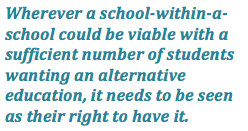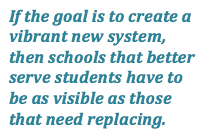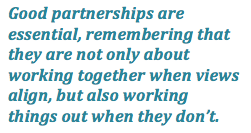An OPERI Report
March 2016
www.operi.ca
Comments from people attending the Ottawa screening of Beyond Measure and the follow-up workshop repeated the view that public education is failing in ways that have dire consequences for students. There was no immediate consensus on how to correct the system, which prompted one participant to say that we had to find common ground upon which to build. Many change efforts crumble at this point. People can’t agree on how to proceed, so they go away and status quo prevails. As discussions at the workshop continued, the idea of schools-within-schools began to emerge as a possible unifier. This idea is developed below with the hope that it will prove to be one upon which an effective 21st century public education system can be built.
Change and Entitlement
Change begins with a single person. He or she gets an idea and it grows from there. In a free market environment, ideas can compete on a relatively equal playing field, but in monopoly situations, like public education, traditionalists can easily overpower the efforts of people wanting to bring about change. If this is allowed to happen, public education will remain out of sync with the times.
There is a human rights element involved with school reform. Students are deemed to be entitled to the education that best suits them.  If they need something other than a traditional education, every reasonable effort must be made to provide it for them in their neighbourhood schools, and without students being labeled as misfits. This supports the idea of schools-within-schools. Traditional school authorities have to resist the propensity to create uniformity, and cultivate instead the diverse learning environments that can meet the needs of all children. Wherever a school-within-a-school could be viable with a sufficient number of students wanting an alternative education, it needs to be seen as their right to have it.
If they need something other than a traditional education, every reasonable effort must be made to provide it for them in their neighbourhood schools, and without students being labeled as misfits. This supports the idea of schools-within-schools. Traditional school authorities have to resist the propensity to create uniformity, and cultivate instead the diverse learning environments that can meet the needs of all children. Wherever a school-within-a-school could be viable with a sufficient number of students wanting an alternative education, it needs to be seen as their right to have it.
Equally Accessible and Visible
It is not enough to make alternatives to traditional education available to students in places other than their local schools. Doing so does not satisfy the condition of equal opportunity. It favours the children of advantaged parents who are able to negotiate the system and provide the needed transportation. With schools-within-schools, students can opt for a different learning environment simply by indicating they want to try an alternative the following year, and by walking through a different door in the same hallway. The only thing students need is their parents’ approval.
Choosing schools in other districts works against the potential of public education to build strong communities. Kids can become strangers in their own neighbourhoods. Worse still, it cultivates a “me-first” mentality with people trying to get the best for themselves instead of working to build the best for their communities. It also contributes to the climate change problem by turning students into commuters when they could be walking or riding a bike to school. Choosing schools-within-schools does not perpetuate these problems.
neighbourhoods. Worse still, it cultivates a “me-first” mentality with people trying to get the best for themselves instead of working to build the best for their communities. It also contributes to the climate change problem by turning students into commuters when they could be walking or riding a bike to school. Choosing schools-within-schools does not perpetuate these problems.
“Out of sight, out of mind,” is an expression relevant to change in public education. If the goal is to  create a vibrant new system, then schools that better serve students have to be as visible as those that need replacing. Alternative schools in other communities are essentially out of sight, and therefore out of mind for many. They are also more likely to be misunderstood. For example, there are parents who believe that the OCDSB Churchill Alternative School is for children with special needs. Schools-within-schools are all equally visible and therefore confusion over what they offer is considerably less likely to occur.
create a vibrant new system, then schools that better serve students have to be as visible as those that need replacing. Alternative schools in other communities are essentially out of sight, and therefore out of mind for many. They are also more likely to be misunderstood. For example, there are parents who believe that the OCDSB Churchill Alternative School is for children with special needs. Schools-within-schools are all equally visible and therefore confusion over what they offer is considerably less likely to occur.
Proponents of school choice, i.e. schools in other districts, like to tout it as providing free market conditions, but it doesn’t come even close to creating them. Free market conditions give individual consumers full choice over what best suits them. Only non-coercive schools like Sudbury Valley give this much choice to students. The question about how “free-market” we want our schools to be still remains, but schools-within-schools would bring us closer to being able to answer it.
Viable Options for Immediate Action
Schools are not going to suddenly flip-flop to a new model. Most active parents still subscribe to the traditional model of schools, and those who think otherwise often don’t agree on the amount of change needed. The goal then is to start conservatively with options that satisfy enough people to make them viable. The level of change offered through schools-within-schools can be incrementally increased as people come to better understand how to achieve the kinds of learning environments and communities we need. As alternative programs prove themselves, more people will opt for them. In this way, schools-within-schools provide a mechanism for evolving public education into a 21st century model with a minimum of disruption.
Elementary Alternatives
At the elementary level, schools-within-schools can be created to offer more students the advantages of alternative schools. The OCDSB provides a good description of the thinking behind its alternative schools. People can drop into Churchill Alternative School on Friday mornings at 8:30 for a tour to witness it in action.
Secondary Alternatives
At the secondary level, schools-within-schools could be styled after the one that was initiated by a student at Monument Mountain Regional High School, which was featured in Beyond Measure. The CHIP program that ran in Ottawa’s Lester B. Pearson Catholic High School serves as another example. OPERI proposes a school-within-a-school that builds on what was learned from the CHIP program. These secondary programs would make good options for students who graduate from OCDSB elementary alternative schools. Given the slow speed of change in public education, these are programs that parents of young families need to be working towards now to have them in place in time for their children.
Where the Onus Lies
Students and parents are unlikely to see the changes they want unless they take matters into their own hands. They have to find others who think like them and help to inform those who have little knowledge of more suitable learning environments. This does not have to be time consuming. Chatting with parents at children’s birthday parties, hockey games or other social gatherings can go a long way towards identifying people who want something different  and opening the minds of others to new possibilities. Talking to school administrators, teachers, and school council members can be done when picking kids up at school and attending school events or interviews. We can’t afford to stay quiet. We have to up the level of talk.
and opening the minds of others to new possibilities. Talking to school administrators, teachers, and school council members can be done when picking kids up at school and attending school events or interviews. We can’t afford to stay quiet. We have to up the level of talk.
School board trustees are important. They have the final say in what the board does. The OCDSB has 12 trustees, which means 7 at least would have to vote in favour of schools-within-schools. It’s never too early to contact them, and it is recommended that groups of 8 to 10 people meet as soon as possib le with their trustees to determine how much they know about the democratic learning model and where they stand on schools-within-schools. A comment written on one of the sheets from the World Café says, “Why do we empower those in power? They only have power over us if we give it to them.” We must not let ourselves think we are insignificant.
le with their trustees to determine how much they know about the democratic learning model and where they stand on schools-within-schools. A comment written on one of the sheets from the World Café says, “Why do we empower those in power? They only have power over us if we give it to them.” We must not let ourselves think we are insignificant.
There is also an onus on OPERI. It has been created to advance the democratic learning movement and to help develop the community building potential of public education. To these ends, it is providing an information sharing service and coordinating grassroots efforts across Ottawa. It also exists to provide the oversight needed to ensure that alternative programs are properly implemented, that good ideas are not discredited by people who fail to understand them, and that promising programs are not sabotaged by people who oppose them.
Becoming a member of the OPERI – Public Facebook group and following OPERI on Twitter @OttawaOperi are ways to keep up to date with information that can help to persuade others to join the change effort. The bigger the number of members in OPERI – Public, and the bigger the number of OPERI followers on Twitter, the stronger the message to the authorities that people are serious about wanting real options.
The Speed of Change
As soon as the demand is identified, a school-within-a-school could begin within a year. It would require that school board personnel be prepared  in advance so that they could be leaders rather than laggards. The screening of Beyond Measure followed by discussions that invite action are an example of how school boards can ready their personnel to be leaders in the change process.
in advance so that they could be leaders rather than laggards. The screening of Beyond Measure followed by discussions that invite action are an example of how school boards can ready their personnel to be leaders in the change process.
Change of this nature does not happen without respectful relations between school boards and their communities. Good partnerships are essential, remembering that they are not only about working together when views align, but also working things out when they don’t.
 Even great ideas come with problems to be solved.The history of education is littered with examples of people running back to the old way of doing things at the first sign of trouble. We can’t continue to act this way. It is now too clear that old methods are harming students. Fundamental change must happen, and the problems encountered along the way need to be attacked with the spirit of Jean Drapeau, the former mayor of Montreal who said, “There are no problems, only solutions.”
Even great ideas come with problems to be solved.The history of education is littered with examples of people running back to the old way of doing things at the first sign of trouble. We can’t continue to act this way. It is now too clear that old methods are harming students. Fundamental change must happen, and the problems encountered along the way need to be attacked with the spirit of Jean Drapeau, the former mayor of Montreal who said, “There are no problems, only solutions.”